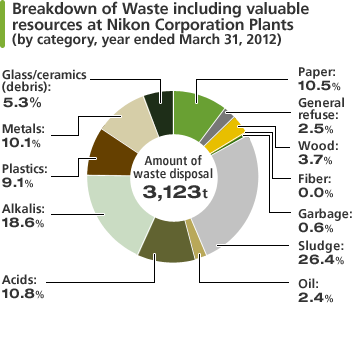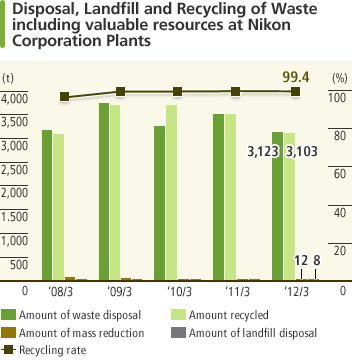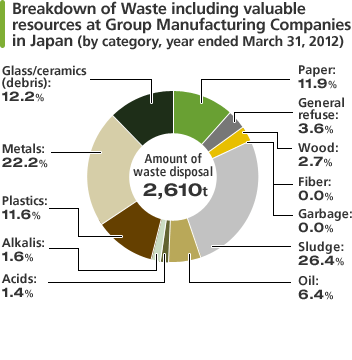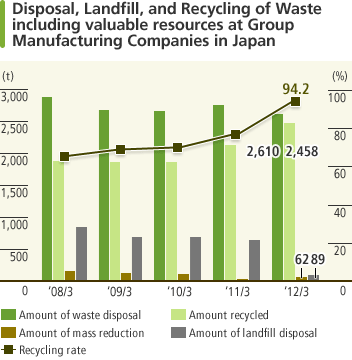Waste Reduction
The amount of waste disposal during the year ended March 31, 2012 by Nikon Corporation was 2,675 tons, while that by Group manufacturing companies in Japan was 813 tons. Together, Nikon Corporation and the Group manufacturing companies in Japan achieved their target of maintaining the same level of waste disposal as the year ended March 31, 2011.
Toward Zero Emissions
In the year ended March 31, 2009, the Nikon Group defined 4 levels of zero emissions* according to the rate of final landfill disposal.
So far, a total of 13 facilities belonging to Nikon Corporation and Group manufacturing companies in Japan have achieved level 1 zero emissions.
-
Four levels of zero emissions
- Level 1: Final landfill disposal rate: less than 1%
- Level 2: Final landfill disposal rate: less than 5%
- Level 3: Final landfill disposal rate: less than 10%
- Level 4: Final landfill disposal rate: less than 20%
- *Zero emissions
A concept proposed by the United Nations University in 1994 with a view to reducing waste from the whole of society to zero by recycling waste from one industry for use as resources for other industries.
Achievement of Level 1 Zero Emissions in the Nikon Group
| Company | System complete (year-end) | |
|---|---|---|
| Nikon Corporation | All plants | March 31, 2003 |
| Group manufacturing companies in Japan | Sendai Nikon Corporation | March 31, 2002 |
| Tochigi Nikon Corporation / Tochigi Nikon Precision Co., Ltd. |
March 31, 2004 | |
| Kurobane Nikon Co., Ltd. | March 31, 2004 | |
| Miyagi Nikon Precision Co., Ltd. | March 31, 2005 | |
| TNI Industry Co., Ltd. Nagai Factory | March 31, 2010 | |
| Affiliated manufacturing companies in Japan | Nasu Nikon Co., Ltd. | March 31, 2006 |
| Aichi Nikon Co., Ltd. | March 31, 2007 | |
| Group manufacturing companies in Asia | Nikon Imaging (China) Co., Ltd. | March 31, 2010 |
Progress made at Nikon Corporation
The amount of waste disposal including valuable resources by Nikon Corporation during the year ended March 31, 2012 decreased 10.5% year-on-year. Moreover, the recycling rate was 99.4% and the final landfill disposal rate was 0.26%, meaning the company maintained its level 1 zero emissions status.
As an example of onsite improvements, the Sagamihara Plant returns the deposition materials used in the vapor deposition processing of lenses to the manufacturers of the materials for reuse, instead of just discarding them. Moreover the plant began selling waste semiconductor parts to recycling companies, thereby promoting both the recycling and cost savings.


Progress made at Group manufacturing companies in Japan
The amount of waste disposal including valuable resources by Group manufacturing companies in Japan (excluding Hikari Glass Co., Ltd.) during the year ended March 31, 2012 increased 0.8% year-on-year. Although the recycling rate decreased to 96.4%, the final landfill disposal rate was 0.3%, and they were able to maintain its level 1 zero emissions status.
In addition, bricks and a portion of Eco-glass* generated at the Akita Plant of Hikari Glass, which used to be landfilled, are now sent to a waste contractor to be recycled into roadbed and other materials. In this way, the plant was able to recycle hard-to-recycle materials and to build a level 4 zero emissions system.


- *Eco-glass
The Nikon Group developed lead- and arsenic-free optical glass for use in the lenses and prisms of optical devices, and calls this type of glass "Eco-glass." The use rate of Eco-glass in optical systems has reached 100% in most Nikon products.
Progress made at Group manufacturing companies in Asia
Nikon Imaging (China) Co., Ltd. commenced activities towards zero emissions during the year ended March 31, 2009. It began with assessing the current situation and examining disposal methods according to waste type instead of sending everything to landfill, and it switched waste processing companies from those that were unable to offer recycling and other such services. As a result of its wide-ranging efforts, it achieved level 1 zero emissions in the year ended March 31, 2010. During the year ended March 31, 2012, it retained level 1 with a final landfill disposal rate of 0.67%. At present, Nikon Imaging (China) is working to recycle waste that is disposed during the cleaning process.
In the year ended March 31, 2012, Nanjing Nikon Jiangnan Optical Instrument Co., Ltd. and Hikari Glass (Changzhou) Optics Co., Ltd. began collecting accurate data on waste disposal with an aim of building a level 4 zero emissions system.
Nikon (Thailand) Co., Ltd. created a zero emissions team and commenced activities in April 2010. These include separating milk cartons from other garbage, as well as incinerating sludge, which is generated during the processing of wastewater from surface treatment and lens processing, in a cement kiln for recycling as a material used in industrial cement. As of September 2011, the final landfill disposal rate was 17%. This is below its voluntary target of 20% for the year ended March 31, 2012, meaning it had built its level 4 zero emissions system. The Thai floods caused production to stop from October 2011, and so no data has been able to be collected, but the company is doing everything it can to restore pre-flood conditions as quickly as possible.
